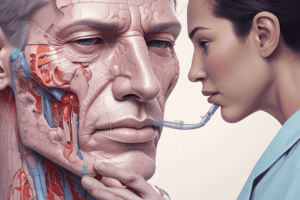Podcast
Questions and Answers
Which rash is typically associated with GAS infection leading to Scarlett fever?
Which rash is typically associated with GAS infection leading to Scarlett fever?
- Pustular rash
- Maculopapular rash
- Urticarial rash
- Sandpapery scarlatiniform rash (correct)
What is the primary reason antibiotics are administered for GAS pharyngitis?
What is the primary reason antibiotics are administered for GAS pharyngitis?
- Preventing acute rheumatic fever (correct)
- Shortening the duration of illness
- Treating tonsillitis
- Alleviating symptoms
Which Centor score range indicates that a patient should be treated symptomatically without testing?
Which Centor score range indicates that a patient should be treated symptomatically without testing?
- 3-4
- 5-7
- 2-3
- 0-1 (correct)
What is a common complication of untreated GAS pharyngitis in elderly patients?
What is a common complication of untreated GAS pharyngitis in elderly patients?
Which of the following treatments is NOT considered appropriate for GAS pharyngitis?
Which of the following treatments is NOT considered appropriate for GAS pharyngitis?
What condition can develop if a GAS pharyngitis goes untreated?
What condition can develop if a GAS pharyngitis goes untreated?
What is a characteristic of maculopapular rashes in the context of infectious mononucleosis?
What is a characteristic of maculopapular rashes in the context of infectious mononucleosis?
Why are elderly patients at a higher risk for complications from infections?
Why are elderly patients at a higher risk for complications from infections?
Which symptom is most consistent with a bacterial cause of pharyngitis?
Which symptom is most consistent with a bacterial cause of pharyngitis?
What examination finding is NOT typical for a viral cause of pharyngitis?
What examination finding is NOT typical for a viral cause of pharyngitis?
Which factor may raise the likelihood of diagnosing GAS pharyngitis?
Which factor may raise the likelihood of diagnosing GAS pharyngitis?
What symptom is typically NOT associated with GAS infection?
What symptom is typically NOT associated with GAS infection?
Which of the following findings is associated with infectious mononucleosis rather than GAS?
Which of the following findings is associated with infectious mononucleosis rather than GAS?
Which detail would help differentiate between a viral and bacterial infection in a patient with pharyngitis?
Which detail would help differentiate between a viral and bacterial infection in a patient with pharyngitis?
What physical exam finding is most associated with a diagnosis of M pneumoniae infection?
What physical exam finding is most associated with a diagnosis of M pneumoniae infection?
Which symptom correlates most with gonococcal pharyngitis?
Which symptom correlates most with gonococcal pharyngitis?
What is the most common cause of pharyngitis?
What is the most common cause of pharyngitis?
Which of the following is NOT one of the Centor criteria for diagnosing GAS pharyngitis?
Which of the following is NOT one of the Centor criteria for diagnosing GAS pharyngitis?
What is indicated by a Centor score of 0-1?
What is indicated by a Centor score of 0-1?
What is the main inflammatory response mechanism in infectious pharyngitis?
What is the main inflammatory response mechanism in infectious pharyngitis?
Which viral infections can irritate the pharyngeal mucosa resulting in pharyngitis?
Which viral infections can irritate the pharyngeal mucosa resulting in pharyngitis?
In adults, what is the positive predictive value of the Centor criteria if 4 criteria are met?
In adults, what is the positive predictive value of the Centor criteria if 4 criteria are met?
What role do M protein fragments play in certain serotypes of GAS?
What role do M protein fragments play in certain serotypes of GAS?
Which factor contributes to the classification of pharyngitis as infective according to its etiology?
Which factor contributes to the classification of pharyngitis as infective according to its etiology?
Study Notes
Pharyngitis
- Pharyngitis is an infection or irritation of the pharynx or tonsils.
- Most pharyngitis cases are caused by viruses.
- Group A streptococci (GAS) is the most common cause of bacterial pharyngitis.
- Other causes include allergy, trauma, toxins, and neoplasia.
Centor Criteria
- The Centor criteria help determine the likelihood of GAS pharyngitis.
- The criteria include:
- Fever (1 point)
- Anterior cervical lymphadenopathy (1 point)
- Tonsillar exudate (1 point)
- Absence of cough (1 point)
- A score of 0-1 makes GAS infection unlikely.
- A score of 4 makes GAS infection likely.
- In adults, a score of 3 has a positive predictive value of around 40% for GAS.
- In adults, a score of 4 has a positive predictive value of around 50% for GAS.
Pathophysiology
- Bacteria or viruses may directly invade pharyngeal mucosa, causing a local inflammatory response.
- Viruses, such as rhinovirus and coronavirus, can cause pharyngeal irritation secondary to nasal secretions.
- Streptococcal infections are characterized by local invasion and release of extracellular toxins and proteases.
- M protein fragments of certain serotypes of GAS are similar to myocardial sarcolemma antigens and are linked to rheumatic fever and subsequent heart valve damage.
Presenting Symptoms
- It is difficult to distinguish between viral and bacterial causes of pharyngitis based on history and physical exam alone.
- Sudden onset of pharyngitis is linked to GAS.
- Pharyngitis after several days of coughing or rhinorrhea indicates a viral etiology.
- Recent orogenital contact suggests possible gonococcal pharyngitis.
- Contact with others who have GAS or rheumatic fever is suggestive of GAS pharyngitis.
- Headache is consistent with GAS infection.
- Cough is not usually associated with GAS infection.
- Vomiting is associated with GAS infection, though not exclusively.
Physical Exam
- HEENT:
- Conjunctivitis may occur with adenovirus.
- Scleral icterus may be seen with mononucleosis.
- Rhinorrhea is usually associated with a viral cause.
- Tonsillopharyngeal/palatal petechiae are seen in GAS infections and infectious mononucleosis.
- A tonsillopharyngeal exudate can occur in streptococcal infection, mononucleosis, and occasionally in M pneumoniae, C pneumoniae, A haemolyticus, adenovirus, and herpesvirus infections.
- Oropharyngeal vesicular lesions are seen in coxsackievirus and herpesvirus.
- Concomitant vesicles on the hands and feet are associated with coxsackievirus (hand-foot-and-mouth disease).
- Lymphadenopathy:
- Tender anterior cervical nodes are consistent with streptococcal infection.
- Generalized adenopathy is consistent with infectious mononucleosis or the acute lymphoglandular syndrome of HIV infection.
- Cardiovascular:
- Murmurs should be documented in an acute episode of pharyngitis to monitor for potential rheumatic fever.
- Pulmonary:
- Pharyngitis and lower respiratory tract infections are more consistent with M pneumoniae or C pneumoniae, especially when a persistent nonproductive cough is present.
- Abdomen:
- Hepatosplenomegaly can be found in infectious mononucleosis.
- Skin:
- A sandpapery scarlatiniform rash is seen in GAS infection (Scarlet Fever).
- Maculopapular rashes are seen with various viral infections and with infectious mononucleosis empirically treated with penicillin.
Differential Diagnosis
- Allergic rhinitis with postnasal drip
- Airway obstruction
- Head and neck neoplasias
- Gastroesophageal reflux disease (GERD)
- Peritonsillar cellulitis
Treatment
- Only patients with a high clinical likelihood of GAS pharyngitis should be tested.
- Patients with a Centor score of 0-1 should be treated symptomatically without testing.
- Patients with a Centor score of 3-4 should be tested or treated empirically.
- This is the criterion standard for diagnosis of GAS infection (90-99% sensitive).
- GAS pharyngitis is usually self-limited and resolves spontaneously in 3-4 days.
- Antibiotics are recommended for treatment of pharyngitis to prevent rheumatic fever.
- Antibiotics, if administered early, can shorten the duration of illness by up to 1 day.
- Treatment options include:
- Penicillin
- Amoxicillin
- Cephalexin
- Zithromax
- Erythromycin
- Clindamycin
- Ceftriaxone
Geriatric Considerations
- Elderly patients are more susceptible to infection due to a weakened immune system.
- Left untreated, pharyngitis can lead to tonsillitis.
- Antibiotics can have many side effects in the elderly population.
- Acute rheumatic fever can be very severe in the elderly.
Studying That Suits You
Use AI to generate personalized quizzes and flashcards to suit your learning preferences.
Related Documents
Description
This quiz covers the essential aspects of pharyngitis, including its causes, the Centor criteria used to assess the likelihood of group A streptococcal infection, and the pathophysiology associated with this condition. Test your knowledge on the symptoms and assessment of pharyngeal infections.




